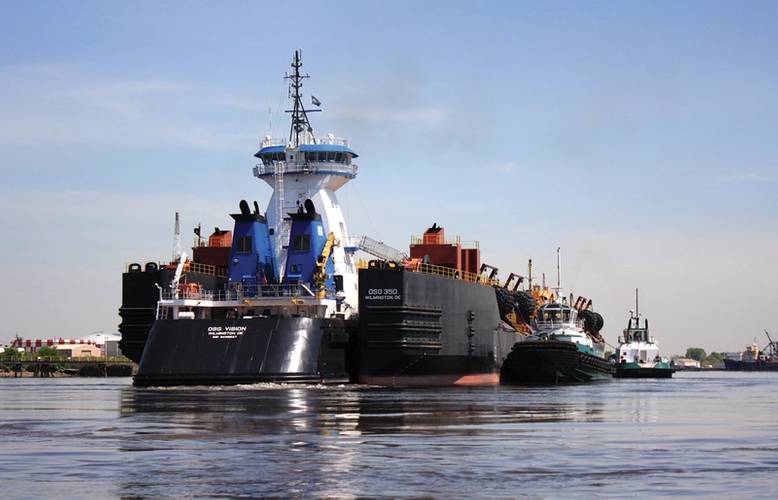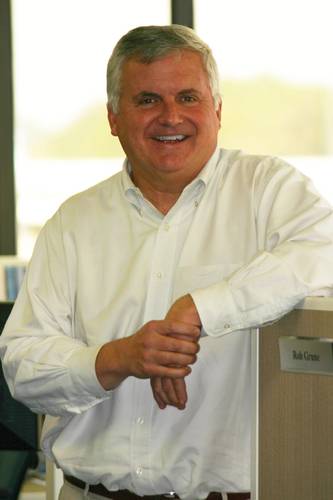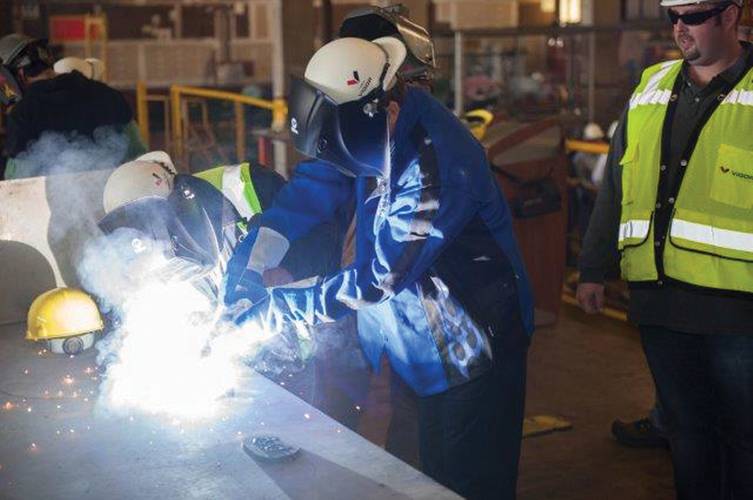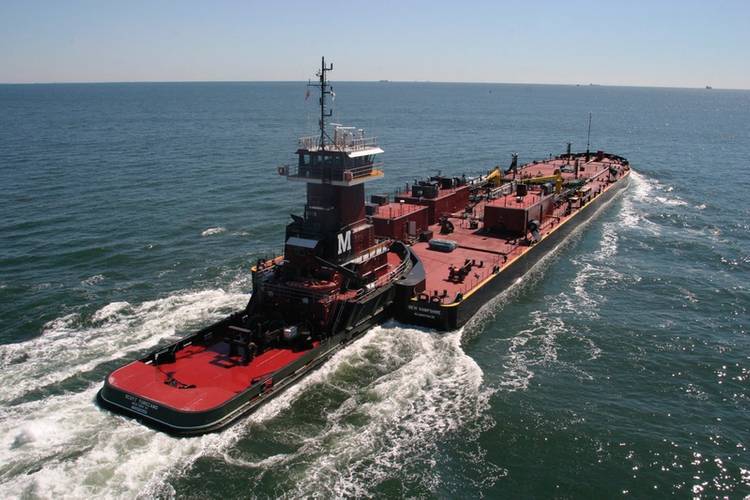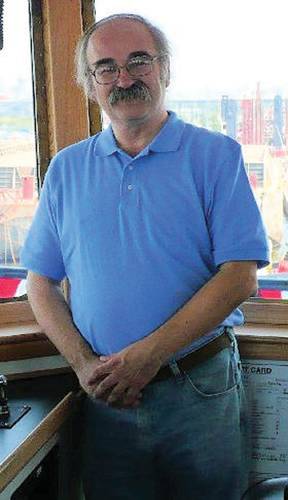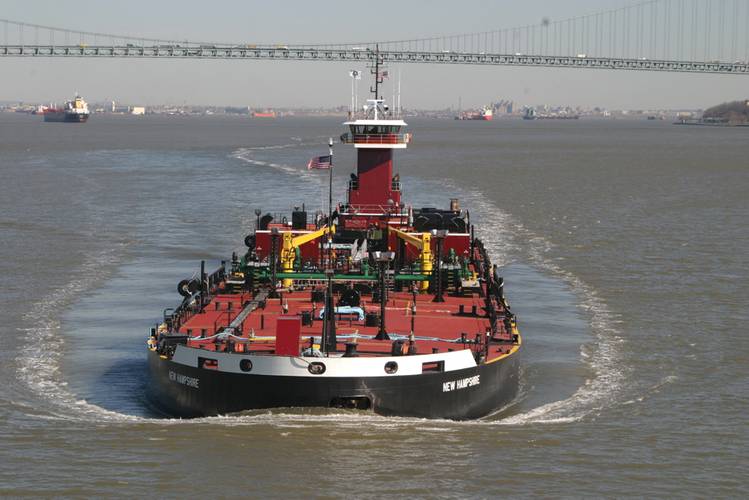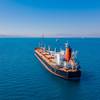Demand for Coastal and Transoceanic ATBs Grows
Along the way, ATBs gain speed, efficiency, safety – and popularity.
Operators of articulated tugs and barges, or ATBs, say they like the maneuverability, weather reliability, stability, speed of these units, and the manner in which the tug pushes the barge. As a marine transportation concept, they can also simply be described as versatile. ATBs move petroleum, chemicals, coal, grain, containerized cargo and rail cars for customers on the U.S. coasts, rivers, the Great Lakes and overseas. As a result, demand for articulated units expanded in the last two decades with new technology.
In 1984, Robert Hill, president and chief naval architect at Ocean Tug & Barge Engineering in Milford, Mass., worked with Intercontinental Engineering-Manufacturing in Missouri, to develop the INTERCON system for ATBs. The INTERCON addressed deficiencies in the existing ARTUBAR and Bludworth connections, Hill said last month. Naval architect Corning Townsend and the Netherlands Ship Model helped produce the INTERCON.
The ATB Connection
The INTERCON is a single-degree-of-freedom connection which, like its predecessors, establishes a transverse, fixed axis between the tug and barge. Movements, including yaw, roll and heave, are restrained. The tug heaves and rolls with the gentler motion of the barge. The INTERCON incorporated the unlimited draft connection of Taisei Engineering’s Articouple system; it eliminated the hydraulic ram as a means of extension, and uses a mechanical screw drive instead.
After the INTERCON was introduced, other engineers improved the Bludworth and ARTUBAR designs, and the Articouple system gained a foothold overseas. Companies eventually turned out in greater numbers to ATBs as a transport solution in the 1990s. Ultimately, Penn Maritime in Connecticut built the first entirely new INTERCON ATB in 1995.
“Starting in 1994, use of ATBs really began to take off,” Hill said. He and his partners worked with hydrodynamic experts to create a barge shape that maximized speed while keeping construction costs in check. Though ATBs are slower than ships, they can reach good speeds. For containers and other light deadweight tonnage, newer ATBs can achieve 15 to 17 knots. Speed is more important in transoceanic ATB voyages than on coastal trips.
ATBs take less time and effort to connect and disconnect on departure and arrival at ports than traditional tugs and barges, Hill said. They eliminate the need to shift from towing to pushing gear when entering a harbor. Safety threats from rigging heavy backing wires are removed. With an ATB, an hour inbound or outbound from harbors can be shaved off a trip.
ATBs run between the West Coast and Alaska. In fact, they run just about anywhere. “They operate transocean, for instance from the U.S. West Coast to islands in the Pacific,” Hill said. “They run from the Mississippi River in Louisiana to Africa with grain for PL 480 food aid. They travel from the United States to Mexico and South America. They go to Newfoundland from the U.S. Atlantic.”
OT&BE Participates in Many U.S. and Foreign Builds
“I’ve continued to design ATBs since1994,” Hill said. “We’ve been busy every year since and remain quite busy.” OT&BE has designed, helped engineer or been involved in other ways in a majority of ATBs now in service in the United States. The company has foreign customers too, particularly in the Far East and Europe. OT&BE collaborates with Connecticut-based CT Marine, which specializes in ocean barge design, model testing, and river and ocean barge hydrodynamics. OT&BE and CT Marine run tests for shipyards and owners. In the Midwest, OT&BE teams with Ohio-based Northeast Technical Services on Great Lakes and other bulk carrier designs.
Crowley Maritime Completed Its Big Build Program
In 2002, Crowley Maritime Corp. in Jacksonville, Fla. launched a more than $1 billion rebuild program that spanned over a decade. Today Crowley owns and operates 17 ATBs ranging in capacity from 155,000 to 330,000 barrels, senior vice president and general manager Rob Grune said last month. These units are chartered to petroleum and chemical companies.
“We were one of the first in the nation to build ATBs for Jones Act transportation,” Grune said. “We responded to an oil company’s West Coast needs back in 2002. At the time, the jury was out about using ATBs on the West Coast because of its steep ocean swells. But the test models we used were successful, and we embarked on building the 550-Class series. Then our customer came back and said in addition they would like a bigger 650 design. We built four 550s and ten 650s, followed by our still bigger 750s.”
Crowley’s 550 Class ATBs were developed and designed for West Coast operations and weather, with advanced safety features such as double hulls, IGS, segregated ballast and radar gauging systems. These ATBs with 155,000-barrel barges were the first in the industry to achieve speeds of 12 knots and handle extreme weather safely, according to Crowley. The company’s four operating 550 Class ATBs, delivered between 2002 and 2003 on the West Coast, are by tug: the Sea Reliance, Sound Reliance, Ocean Reliance and Coastal Reliance.
Crowley operates ten 650 Class ATBs carrying 185,000 barrels each in the U.S. Gulf and on the East and West Coasts. These vessels can maintain 12 knots and travel in bad weather. They were designed for modification to transport EZ chemicals, including cyclohexane, paraxylene and styrene. The first of the company’s 650 Class ATBs was christened in 2006. Tugs in the series are the Pacific Reliance, Gulf Reliance, Resolve, Integrity, Courage, Commitment, Pride, Achievement, Innovation and Vision.
Crowley’s newest ATBs, the 750 Class, can carry 330,000 barrels of petroleum products and are the most innovative in its fleet. The company operates three 750 Class ATBs along the U.S. Gulf Coast for Marathon Oil. These tugs are the Legacy, Legend and Liberty. The 750 Class barges are 45,000 deadweight tons and 600 feet in length. All three barges were built by VT Halter Marine in Pascagoula, Miss. The 16,000 horsepower tugs were constructed by Dakota Creek Industries in Anacortes, Wash.
Crowley christened the Legacy in New Orleans in 2011 and the Legend in Tampa in 2012. Its 17th ATB, the Liberty was christened in May of last year at VT Halter in Pascagoula. “Manning on an ATB is greater than on a towed tug and barge, and the real cost of operating an ATB is higher than a towed barge,” Grune said. “The main reasons we’ve gone to ATBs are to gain some speed, efficiency and safety.” Jacksonville-based Crowley Holdings Inc., is a private holding company for 121-year-old Crowley Maritime. The firm provides transportation and logistics to domestic and foreign customers.
Moran’s New Builds Followed Acquisitions
Moran Towing Corp. in New Canaan, Conn. operates six liquid petroleum ATBs, along with a dry bulk ATB that was added several years ago, company president Ted Tregurtha said last month. Moran’s first ATBs were acquisitions and conversions, and they were followed by new builds. Those units operate along the U.S. East and Gulf Coasts.
“We’re shipping more unconventional oil now than we did in the past,” Tregurtha said. Unconventional oil includes products from shale, sands, coal and biomass; synthetic crudes; and gas to liquid from gas processing. “Our dry bulk ATB carries grain for a commercial customer from New Orleans to Puerto Rico,” he said. The Mary Ann Moran tug pushes the 531-foot barge Virginia to San Juan for Conagra.
The company acquired New York-based Turecamo Maritime and its affiliates in 1998. Moran’s first ATB tug, the Scott Turecamo, was a conversion. The vessel, built in 1998, was retrofitted in 2005. Moran converted the ATB Barney Turecamo in 2005 with an INTERCON connection. For the ATB Paul T. Moran, Moran acquired the tug and barge from two different owners. In 2005, the barge was modified to receive a Bludworth coupler system.
Pati R. Moran, launched in 2008, was the first of four new-build ATBs in the Moran fleet, with all tugs designed by OT&BE and built by Washburn & Doughty shipyard in Boothbay, Maine. The Pati R. Moran is paired with the 425-foot, 118,000-barrel barge Charleston, built in 2007 by Manitowoc Marine in Wisconsin. The Linda Moran was delivered in August 2008, slightly more than a month after a major fire at the Washburn & Doughty shipyard. She is married to the 425-foot, 118,000-barrel double-hulled barge Houston, also built by Manitowoc Marine in 2007. The Lois Ann L. Moran, delivered in September 2009, is coupled with the Philadelphia, built in 2008 by Eastern Shipbuilding of Panama City, Fla.
ATB tug Mary Ann Moran was delivered in late 2010. The 121-foot vessel has 5,300 hp worth of EMD power and an INTERCON coupler system. The tug was matched with Moran’s dry-bulk barge Virginia after it was converted with an upgraded notch to accept the INTERCON coupler. The Virginia was built in 1982 by Galveston Shipbuilding in Texas and was converted at Gulf Marine Repair in Tampa for service as an articulated barge.
Except for its Bludworth model, Moran’s ATB barges are equipped with INTERCON’s C-series couplers. Moran’s barges are mostly interchangeable with their tugs. Tregurtha also addressed ATB crew sizes and costs. “Petroleum ATBs operating in the United States typically have a crew of 8 and 11 people,” he said. “That’s more than an old-style towed oil barge might have.” ATBs can be economical for short distances while tankships are more cost effective for moving large parcels longer distances, he said.
“Based on customer needs, it’s highly likely we’ll build more ATBs,” Tregurtha said. This spring, Moran contracted with Wisconsin-based Bay Shipbuilding Co., a division of Fincantieri Marine Group, to build three oil/chemical barges and two tugs to be operated together as ATBs. Two of the barges will carry 150,000 barrels, and the third will hold 110,000 barrels. The two tugs--one 6,000 hp and one 5,300 hp--will be delivered separately over the next 24 months. Construction has begun on the first units.
Harley Marine Contracts for ATBs
Seattle-based Harley Marine Services’ first ATB is under construction now, following a recent in-house study. “This ATB will allow us to provide better coastal petroleum transportation with faster delivery,” founder and CEO Harley Franco said last month. “It will be reliable in adverse weather. And it will allow us to use less fuel for coastal deliveries, reducing the company’s carbon footprint.” Additionally, the articulated unit will give its crew safe access to the barge and cargo tanks during voyages.
The company partnered with Zidell Marine Corp. of Portland, Ore. for the barge and Conrad Industries in Morgan City, La. for the tug. Harley expects its first ATB to enter service late this year, joining the Olympic Tug & Barge fleet in Seattle. The ATB has a double-hull barge with a hull length of 422’ 3”, a molded beam of 76’ 8” and a depth amidships of 27’ 10.” The barge will have a carrying capacity of 83,000 barrels and will be paired with a 4,070 horsepower twin-screw tug. The tug will be 116’ long, with a molded beam of 36’ and a depth of 16’ 9.”
Harley Marine plans to another two ATBs. Both of them will be 83,000-barrel tank barges, to be constructed by Vigor Industrial in 2015. All three ATBs will have technically advanced, environmentally friendly equipment so that the company can continue providing safe, reliable and efficient service, Franco said. “Our future plans may include building more ATBs to meet growing demand for coastal petroleum transportation,” he said.
GLDD Orders a Dredge ATB
ATB’s can be fitted for dredging, too. At Great Lakes Dredge & Dock Co. in Illinois, vice president Bill Hanson said last month, “We’re in the design phase for our first hopper dredge ATB, which is scheduled to be delivered in 2016. This will be the first dredge of its type ever built, and we’re excited to be in the lead. Its uses will include coastal protection, harbor deepening and channel maintenance projects.”
In January, GLDD contracted with Eastern Shipbuilding to build a hopper dredge ATB unit, with a 433’ trailing suction hopper dredge barge and 158’-4” 15,600 BHP, CPP tug. The tug’s engineering details are being done by Ship’s Architect, Inc. and the barge’s details are by Bay Engineering, with both plans based on an OT&BE design.
A GLDD contract with Signal International in August 2012 to build the ATB dredge was terminated. GLDD’s $140 million contract with Eastern compares with $94 million it had agreed to pay Signal. The GLDD dredge will work to restore eroded land along the Gulf Coast, and will deepen and maintain waterways and ports as the nation accommodates larger vessels, especially from the expanded Panama Canal, starting in 2015. GLDD owns and operates over 200 specialized vessels, and is the largest provider of dredging services in the United States and operates internationally.
Outlook: Orders for 2016 – to – 2017 Abound …
ATBs will continue adjusting to the times, Hill and operators said. The initial appeal of ATBs was that federal regulations allowed them to have relatively small crews. But today most tug and barge customers, particularly major oil companies, are concerned about safety and spills and don’t want to be understaffed. Meanwhile, the industry is considering alternative fuels. “We have two ATBs under design now that will burn LNG, and one of them is duel fuel, using diesel and LNG,” Hill said.
Looking ahead, “we have inquiries from customers to take delivery in 2016 and 2017,” Hill said. “The future is very bright domestically and overseas. ATBs are cheaper than using rail. We’re building for oil and chemicals. Overseas, the Orient has more than 200 ATBs now.”
Today, almost 90 ATB units are active in North American waters and that number will grow significantly in the near term. As many as 10 more can be counted amongst the active order books at the nation’s shipyards. Beyond this, and buoyed by the ongoing domestic energy ‘boom’ and an economics model that works well in Jones Act cabotage trades, it’s virtually certain that this unique transportation system will remain a part of the nation’s intermodal transportation solution. There aren’t too many things you can count on in today’s rapidly changing domestic waterfront, but the ATB apparently holds a spot on that short list.
(As published in the July 2014 edition of Marine News - http://magazines.marinelink.com/Magazines/MaritimeNews)










